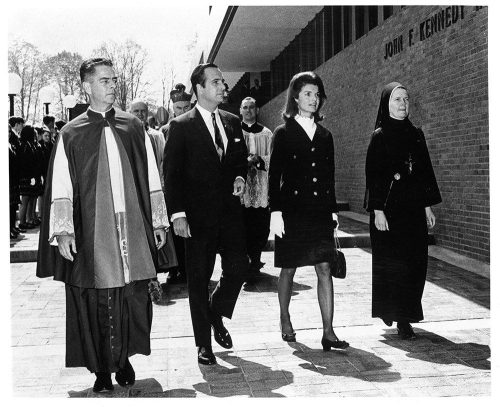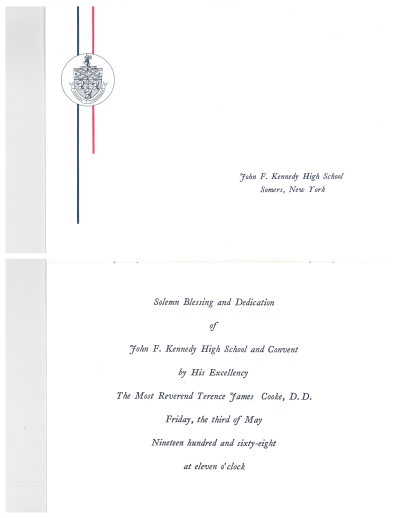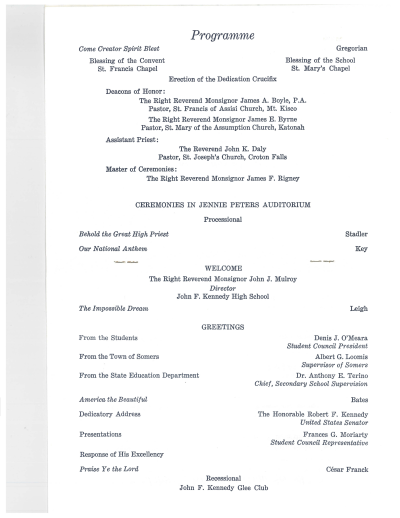Any member of the student body or faculty can recognize the recent changes and improvements that have occurred in our school, whether it is the renovated HVAC system, the new roof, or the anticipated addition of a middle school student body through St. Mary’s Academy. However, few are aware of the many developments that have occurred at Kennedy since its creation, and more generally the historical events that surrounded its dedication in 1968. In living through such momentous times as these, we are called on to examine our history as a school and the people who inspired its creation and mission. Originally founded in 1924 by the Sisters of the Divine Compassion, St. Mary’s High School in Katonah was expanded and relocated to Somers in order to meet the rising demand for Catholic education in Southern New York State. It was decided that St. Mary’s was to be renamed John F. Kennedy Catholic High School in honor of the late thirty fifth president, the first Catholic president of the United States. The dedication ceremony was attended by members of the local governments, clergymen, and none other than the late president’s widow Jackie Kennedy. After her husband’s death, Jackie worked tirelessly to propagate her husband’s influence and legacy by educating the American populace on his life and attending many dedication ceremonies in honor of her husband. In looking back on our history as a school we ought not forget the life of Ms. Kennedy and her contributions to both her country and our school.

Jaqueline Bouvier Kennedy was born July 28, 1929 in Southampton, NY. The child of a Wall Street stockbroker John Bouvier and wealthy socialite Janet Bouvier, Jackie grew up in the lap of luxury amongst the highest and most privileged members of New England society. From a young age she was enraptured by books, as she reported in an essay that she wrote for Vogue at the age of twenty two, “There were Chekov and Shaw in the room where I had to take naps and I never slept but sat on the window sill reading, then scrubbed the soles of my feet so the nurse would not see I had been out of bed. My heroes were Byron, Mowgli, Robin Hood, Little Lord Fauntleroy’s grandfather, and Scarlett O’Hara.”
Despite the seemingly rich abundance of her childhood, Jackie’s earliest years were marked by misery and sorrow. Her father’s alcoholism and blatant infidelity to her mother resulted in her parents’ divorce when Jackie was ten years old. The trauma that resulted from this domestic upheaval caused her to act out at school and become increasingly reserved and introverted. One of her teachers at Miss Chapin’s School in the Upper East Side, which Jackie attended for seven years, reportedly said that she was, “a darling child, the prettiest little girl, very clever, very artistic, and full of the devil.” However, this episode did not last for long and she was soon ranked at the top of her class. Jackie’s commitment to academic excellence remained unwavering from that point on, which is evidenced by her eventual admission into the prestigious Miss Porter’s School in Connecticut. After graduating from Miss Porter’s in 1947 with an outstanding academic reputation and an award for literary excellence, she was admitted into Vassar College, an elite college that at the time was reserved for females.
After transferring to Smith College and eventually obtaining her degree from George Washington University, Jackie was hired as an investigative photographer and journalist with the Washington Times-Herald based in Washington D.C. It was here where she first met John Fitzgerald Kennedy, at the time a young senator from Massachusetts, although they would only become romantically involved many months later. Jackie was entranced by his charm and intellect, and the relationship progressed very quickly. In May of 1953, awaiting her return from a trip to England where she covered the coronation of Elizabeth II, Jack proposed to Jackie.
The first months of Jackie and Jack’s relationship were gruesome. After giving up her position at the Washington Times-Herald Jackie felt increasingly isolated from the world around her which she had such zeal for, and she began to feel equally distant from her husband as he pursued his lofty political aspirations. This prompted her to enroll in American history classes at Georgetown University so that she might become more connected to her husband’s world. The individuals closest to the couple, Jack’s team and his family, soon realized what a valuable asset Jackie could be to Jack’s career. She played an instrumental role in Jack’s political campaign for the 1960 presidential election, overcoming her still shy nature to make public appearances and speak to crowds about her husband.
On January 20, 1961, Jackie became the youngest First Lady of the United States at only thirty one years old. Despite this, everyone around her in the White House, as well as those in the international community, recognized and admired her maturity, grace, and quick wit. She worked extensively to make Washington a cultural hub, inviting some of the greatest artists, poets, and thinkers of the day to the capital to promote her vision. She also took on the gargantuan task of restoring the White House building itself, renovating all of the spaces and restoring not only its classic beauty but also its historical relevance. Besides this, she took steps to cater to the White House staff of the day and their children, most notably by establishing a kindergarten for the staff’s children in the White House nursery. On John’s international trips, which Jackie almost always accompanied him on, she drew the attention of international audiences and the laudation of foreign leaders. At a summit in Vienna in 1961 the media requested that leader of the Soviet Union Nikita Khrushchev pose for a photo shaking hands with President Kennedy, to which he famously responded, “I would rather shake her hand,” referring to Jackie.
Jackie had so invested herself in her role as First Lady that she quickly became a national icon. She was lively and clever yet restrained and reserved; she was fiercely independent but always supportive of her husband and her family. She was complex and nuanced but remarkably relatable. These traits were what won the hearts of so many Americans, but it wasn’t until November 22, 1963 that her prodigious honor and dignity placed her among the most defining figures in America’s history. On this day, while riding in a motorcade with her husband in Dallas, President Kennedy was shot and killed on national television. In this moment and indeed in the days, months, and years to come Jackie Kennedy showed her incredible strength and fortitude to the nation. Jackie wore her pink suit stained with her husband’s blood until the morning after the assassination, so that the public may “see what they did to Jack”, as she said herself. She faced the media and the entire country with remarkable composure, not shedding a single tear in public in the aftermath of the event.
If we are truly the beneficiaries of the legacies left to us by the generations of the past, then the most essential action we must take as humans is to look back on our history and see what got us to where we are today. By refusing to take time to learn about our history and our heritage then we fall victim to ignorance, one of the biggest plagues on mankind. The images of Jackie Kennedy grieving after the assassination of President Kennedy have become ingrained into the American conscience and remain a fundamental part of our development as a nation, and this has been aided by the work Jackie took on in actively promoting the legacy of her husband, our namesake.
However, one detail that has been lost to history is the fundamental role that Jackie Kennedy played in the dedication of our school in 1968. Many members of the student body today are unaware that Ms. Kennedy herself attended our school’s dedication ceremony. Senator Robert F. Kennedy, John F. Kennedy’s brother was invited to speak at the ceremony, but Jackie was substituted as he was unable to attend. Sister Barbara Heil, former Latin teacher at Kennedy Catholic who was present at the ceremony, said of the day, “The youngsters were all lined up out there in front to be a guard of honor for her. She was extremely gracious and very, very well composed but she was very friendly, went around to all the classrooms, sat on the stage perfectly still. She didn’t speak to the audience but she was there and her presence was felt and she was very impressed with what we had done to set up for her.” Jackie clearly left a significant impression on the student body fifty four years ago, and she should continue to serve as a source of inspiration to us today. Her continued commitment to academic excellence and the furtherance of education, her love of culture and her passion for life itself, her Catholic faith and her family values, and her efforts to ingrain the details of President Kennedy’s life into the hearts and minds of all Americans should be admired – not with the distant gaze that our eyes often rest on history, but with active and fervent appreciation and gratitude.



To promote the Kennedy legacy and to honor the creation of our school, Kennedy Catholic will open what is known colloquially as the “White House” to the public and rebrand this historic building as Alumni Hall on Wednesday, March 16. Records that date from the building, creation, and opening of the school will be housed here, and the Advancement Office will be relocated here as well. It is our hope that Alumni Hall will act as a welcome center for alumni and donors to the school and serve as a cultural preservation center for our school’s rich history. If you would like to learn more about the construction of the school building, the dedication ceremony, or Kennedy’s first graduating class, please contact [email protected] or call 914-232-5061 and ask for the Advancement Office.
For more information on the life of Jackie Kennedy or the Kennedy Presidency, please consult these sources:
Salinger, Nicole. Jackie. Universe Publishing, 1998.
Dherbier, Yann-Brice, and Pierre-Henri Verlhac. Jackie: A Life in Pictures. PowerHouse Books, 2004.
“Life of Jacqueline B. Kennedy.” Life of Jacqueline B. Kennedy | JFK Library, John F. Kennedy Presidential Library and Museum, https://www.jfklibrary.org/learn/about-jfk/life-of-jacqueline-b-kennedy.